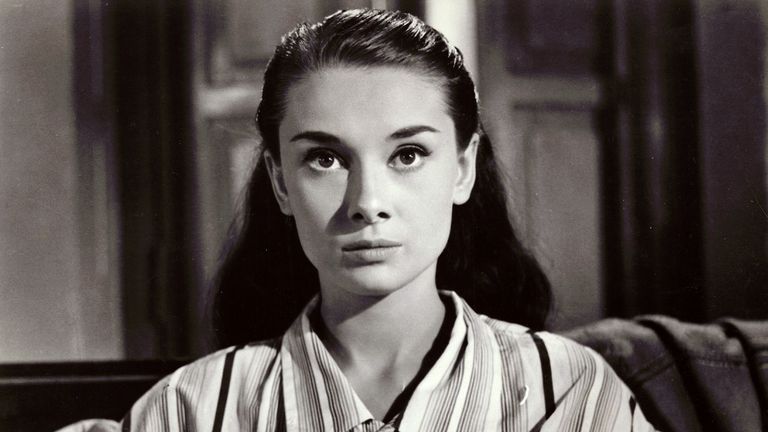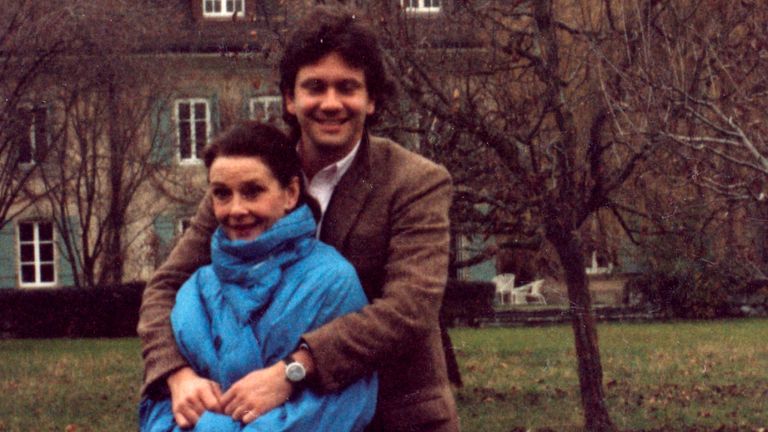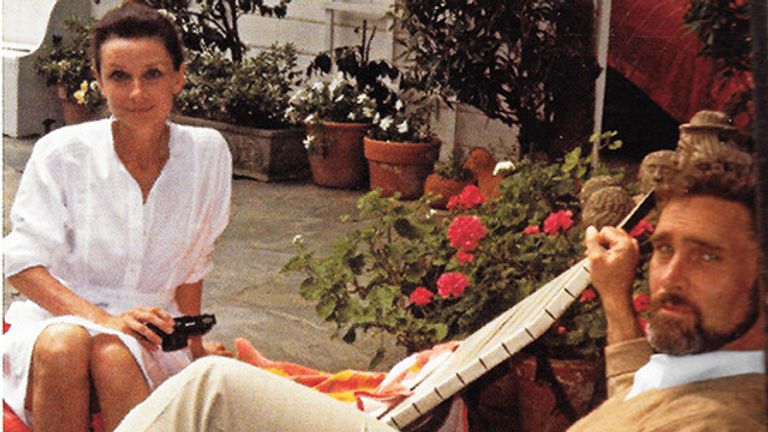Cultural icon, fashion muse and celebrated beauty – Audrey Hepburn left an indelible mark on the world.
But despite her outward success, her life was haunted by loss.
Sean Hepburn Ferrer, Hepburn’s eldest son, tells Sky News that one of the deepest losses in her life was the miscarriage of a baby girl when she was six months pregnant.
At a time when both royalty and celebrities are beginning to talk openly about miscarriage, it’s hard to appreciate the silence around the issue in the late 1950s and 1960s when Hepburn was at the height of her fame.
As Hepburn Ferrer explains: “It was typical of that generation not to be coochie coochie and warm and fuzzy… Disney introduced that concept.”
Hepburn suffered two miscarriages, one shortly after falling from a horse during filming, but it was the second that was the most deeply traumatic.
Hepburn Ferrer says: “I know that the second loss was, which was at six months [in the pregnancy], was very hard. It was a little girl and she was going to be my older sister.
“That was very hard, even though the first [miscarriage] was tough, but it was early on in the pregnancy.
“What happens is exponential – the first one is a tragedy and the second one is not just another tragedy, but it gets you so many more miles away from thinking that you’ll ever be able to have a child.
“And there was no explanation. People didn’t know about incompetent cervix or about any of that in those days…
“We all came from a culture of you got to keep moving, you got to keep doing.”
Now better understood, cervical incompetence is when a muscle weakness in the cervix causes it to open too early in the pregnancy, which can lead to a miscarriage.
Hepburn Ferrer explains that it was only after a period of bed rest that Hepburn was able to fall pregnant again and carry the baby to full term.
“She was very happy when I was born,” he says.
One of the world’s most in-demand actresses – and the first to command $1m along with Elizabeth Taylor – Hepburn walked away from the industry for 10 years to focus on her family.
Although unimaginable to some who couldn’t believe she would turn her back on such success, Hepburn had no doubts.
She said she had “always wanted to be a mother” and knew since she was a child that “I was going to grow up and have lots of babies… It’s what’s made my decisions always”
She even went so far as to say: “For children I’d go to the moon.”
Hepburn’s love of children and desire for a family is one of the central themes of a new documentary about her life, ‘Audrey’ features previously unseen footage and interviews with those who were closest to her.
Her granddaughter Emma Ferrer tells Sky News: “It was valuable to me to deconstruct the myth and on a personal level, to have her humanised.”
Director Helena Coan tells Sky News that it was one previously unheard two-hour audio interview that gave her a rare insight into the real Audrey Hepburn.
“I remember listening to it in headphones and she’s just in a hotel and kind of eating lunch and talking. And I just felt very close to her then.”
In the documentary we see handwritten letters from Hepburn to directors including Stanley Kubrick turning down lead roles so she could stay at home with her family.
Hepburn had two sons; Sean, with her first husband, actor Mel Ferrer, and Luca, with second husband, Italian psychiatrist Andrea Dotti.
Hepburn Ferrer says there was very little talk of Hollywood and showbiz at home, and that they rarely took videos or photos of one another.
“We weren’t a home-movie kind of a family. When that’s your work and you have to do it for a living, when it’s Christmastime, you don’t want to see a camera in the room.”
Despite her devotion to motherhood, Hepburn’s relationship with her own mother was not so close. However, Hepburn Ferrer says his Grandma Ella had her own battles to contend with.
“This is a woman who was a single mum at a time when women couldn’t wear pants [trousers] or open a bank account without a man’s permission. Who picks up after the war without a nickel and brings [her daughter] to London from Holland and puts her in a ballet school.
“And within five years, [Hepburn’s] standing in Hollywood with an Academy Award… The story of the power and the strength begins with Ella.”
He says Hepburn’s own strength “was a combination of the grandmother, the upbringing, the war, the hunger, and the arduous ballet training”.
A child of World War II, Hepburn suffered starvation and malnutrition while hiding from the Nazi’s, at one point surviving on just water and nettles.
She was also deeply hurt by the loss of her father when he walked out when she was six years old, just days before World War II broke out in September 1939.
Hepburn Ferrer explains: “She never got over the loss of her father, or let it go”.
Hepburn herself has described her father’s desertion as: “One of the great traumas of my life. It left a very deep scar on me.”
She was reunited with him as an adult, after tracking him down in Ireland, but they had never become close, or talked about his decision to leave.
In the documentary, Hepburn is described as “an iron fist in a velvet glove”, and it’s a strength she no doubt had to call upon after shooting to fame with her Oscar-winning performance in 1953 comedy Roman Holiday.
Thrust into the limelight, Hepburn suddenly found herself surrounded by adoring fans and relentless paparazzi.
Hepburn Ferrer witnessed the scramble for pictures of his mother first-hand: “I saw both sides, I saw normality in Switzerland as a kid and later on I saw the insanity of it all in Italy, which almost becomes hard to live with.”
Coan says she thinks it was when Hepburn lived in Rome that she found the paparazzi most difficult to deal with: “When Luca was born, her second son, she couldn’t put him anywhere without someone taking a photo of him.
“Being a mother was important to her, and I think when [her fame] started to affect her children’s lives, that was definitely something she struggled with. It was difficult watching footage or seeing photos of her where she’s obviously uncomfortable and wanting to protect her children.
“She was so magnetic as a figure. She was relatable. She was one of us rather than one of them. And I think it just makes people want to hold her hand. You see footage of her that’s like the Beatles getting off planes and people screaming. I think it did get overwhelming for her at times.”
Ferrer Hepburn even remembers one occasion when, after growing a beard as a young man, he was snapped with his mother by photographers in the street. The next day he saw himself branded “Hepburn’s new love” across magazines and papers.
It was a clipping he says Hepburn cut out and put in a frame next to her bed, joking that it was “the first time they got it right”.
Despite her photogenic appearance, and the fact she has regularly been voted one of the world’s most beautiful women across decades, Hepburn never truly believed in her own good looks.
Hepburn Ferrer explains: “She was humble and put herself down. She felt her feet were a little too big and she had a bump on her nose and a crooked tooth.
“But she didn’t get the tooth fixed. She didn’t get the nose broken and set straight. She worked with what she had.
“We root for her because she’s the normal girl with the perfect package of imperfection from across the landing, who goes out in the little black dress into the world and is able to win us over.”
Known for her life-long collaboration with designer Hubert de Givenchy, the documentary lets Hepburn describe in her own words the secret motivation behind her fabulous on-screen costumes: “I’m terribly self-conscious about myself, and clothes always give me a great deal of self-confidence”.
But according to her son and granddaughter, when at home, Hepburn was a fan of dressing down, loving nothing better than slipping into “a sweater and slacks”.
As Hepburn Ferrer explains, the film “undresses the myth to get to the woman”, showing that her talents were about “so much more than just looks”.
He says Hepburn “wasn’t just this lovely gamine waif with whom the world fell in love, but she was also a woman with a vision, with strength, with tremendous depth.
“You’ve got to have something more than just looks and cuteness to become this kind of a legend.”
Coan says her favourite footage of the star is her wearing a brown jumper and jeans with very little make up on.
It was a dress code she was better able to deploy in the latter part of her life, when she devoted the majority of her energy to humanitarian work, often alongside her third partner, Dutch actor Robert Wolders.
Hepburn Ferrer even jokes that her calling may have led his mother to be the founder of the first capsule wardrobe.
“She had to boil down her wardrobe thanks to working for UNICEF and the necessity of having to travel. She’d go to a developing nation and then go to Washington DC and meet the press and the president of the Congress or the Senate, and she had to do it all out of two suitcases.”
He says a few months after Hepburn’s death, he cleared out her dressing room and found that “out of eight of her double doored closets, there were only two that had clothes in, because over the years she had distilled it down to the absolutely bare essentials.”
He goes on: “She always used to say that she dressed more like an English gentleman than a woman because she felt that look fitted her, and so she stuck to it through the ages.”
After herself having been helped as a child by Red Cross & UNICEF during World War II, Hepburn’s life came full circle, and she spent her final years campaigning on behalf of disadvantaged children.
It was a calling that also led back to her own childhood loss, as her granddaughter says “she wanted that phantom figure of her father to fill that void”.
Hepburn Ferrer agrees that his mother probably never got over the loss of a parent so early on her life, but that the experience shaped it.
“It created a yearning which transported her all the way to better understanding those feelings and those emotions, not just in characters that she played, not just in other people and understanding them, but all the way to the loneliness of a refugee.”
:: Subscribe to the Backstage podcast on Apple Podcasts, Google Podcasts, Spotify, Spreaker
As to whether she found happiness in her final days, her son is resolute: “Did she love herself, was she at peace with herself in the end? Yes.”
Hepburn died of appendiceal cancer on 20 January 1993 aged 63, at her home in Switzerland surrounded by her family.
Starring in nearly 30 films over five decades, Hepburn remains one of only 16 people who have won Academy, Emmy, Grammy, and Tony Awards.
‘Audrey’ is streaming on all major digital platforms from Monday 30 November.











